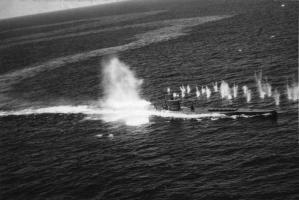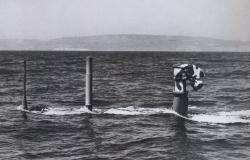
|
|
SUBSIM: The Web's #1 resource for all submarine & naval simulations since 1997
 |
SUBSIM: The Web's #1 resource for all submarine & naval simulations since 1997 |
|
|
 02-10-07, 08:58 PM
02-10-07, 08:58 PM
|
#1 |
|
Admiral
 Join Date: Apr 2005
Location: Australia:- Sydney
Posts: 2,049
Downloads: 68
Uploads: 0
|
Remaining Invisible
The most vital asset of a U-boat is the element of surprise. A U-boat possess an exceptional ability to attack and withdraw without being detected. For this, a skilled commander must make every effort to ensure that his boat remains unseen. In U-boat school, commanders are guided by the principle, “He who sees first, has won!”. This is especially true, in order to prevent the boat from being sighted. Thus, it is of paramount importance that sharp lookouts be posted when operating on the surface. Keeping a vigilant lookout is tiresome, consequently, crews on watch duty should be punctually relieved by the next shift. Four lookouts are posted on the bridge, each systematically organized to scan a 90 degree sector of the U-boat. The horizon is scanned for ships, or for smoke on the horizon, indicating an impending ship. The sea surface is scanned for periscopes and the sky for aircraft. Under no circumstances are lookouts allowed to deviate from their duty. Even during a deck gun engagement, lookouts are not allowed to witness the battle, for fear that the U-boat might be surprised by a lurking enemy. Particular attention should be paid to the sun sector, as visibility is always impaired when looking into the sun’s direction.    Four lookouts scanned the horizon, which was divided into four zones of 90 degrees each. From the air, it is the wake of a U-boat which is spotted first, rather than the boat itself. Posting a lookout on a raised periscope. When cruising on the surface, care should be exercised not to raise the periscope, especially during daylight. When submerging, the periscope should be raised only after the boat has completely submerged. In the same manner, the periscope should be completely lowered before breaking the surface. In clear weather, a lookout with binoculars can be hoisted up on a raised periscope for an all round view, but this should be used sparingly as the dangers are two fold; it takes much longer to crash dive in the event an enemy aircraft is spotted, and a U-boat with a raised periscope is much easier to spot. As a principle, in clear weather, it is always better to submerge too early, than to submerge too late. At the latest, a U-boat must submerge when the funnel top of the enemy ship is sighted. Warships often have lookout posts on the top of his masts, who are not only equipped with powerful binoculars, but also range finders with powerful optics. The dangers of being sighted are too easily underestimated. In poor visibility, it would be better to submerge as the hydrophones can detect ships much further than the lookout can see. However a U-boat’s place is on the surface and as soon as the weather permits, the U-boat must surface. By characteristic of a submerged U-boat, it is slow and blind, and leads to passivity and lost opportunities of attack. Furthermore, a U-boat should not remain in the vicinity of where it had submerged. Traces of diesel may be left behind when ballast tanks are flooded, and it is best to sail to another location. When submerged and stalking the enemy, it is safe to raise the periscope at 4,000 to 5,000 meters from the enemy. At closer distances, the periscope must be used sparingly, exposing the tip only intermittently and while traveling at low speeds to create less of a wake. Before surfacing, an all round sound sweep must be performed at a depth safe from ramming (approx 20 meters). The U-boat then surfaces to periscope depth, an all round periscope scan is performed with and without magnification. When all is clear, break surface at high speed. The commander and a lookout rushes aboard and a thorough all-round scan is performed. Only then, it is safe to completely empty the ballast tanks of water.  The wake of the periscope is less visible when travelling slowly, or in choppy seas. As for air attacks, the best defense against aircraft is to spot it in time and crash dive to safety. Unless otherwise confirmed, every aircraft sighted should be treated as hostile. In clear weather, it is better to remain on the surface and keep a vigilant lookout for aircraft. Although the dangers of air attack exists, it is possible to spot the aircraft in time than to remain submerged and lose valuable opportunities of attack. In low visibility, or on days with thick could cover, it might be advantageous to submerge to prevent surprise air attacks. Visibility conditions from within an aircraft isn’t any better. It is very difficult to spot a U-boat from the air, and more often than not, it is the wake of the boat which is spotted first, rather than the boat itself – particularly if the boat is cruising at high speed. A U-boat is particularly difficult to spot when sailing on choppy waters and wavy seas, rather than on calm seas. Turbulent sea conditions, such as those in the Baltic, the Mediterranean and near river mouths therefore present better cover for U-boats. When submerged, it becomes very difficult, but not impossible to sight a U-boat. On clear weather, when the sun pierces into the water, on a calm sea, and with the aircraft flying almost directly overhead, it is still possible to spot a submerged U-boat. However, without these ideal conditions, a submerged U-boat would be safe from aircraft detection. Don't give up Captain ! 
|

|

|
 02-10-07, 09:03 PM
02-10-07, 09:03 PM
|
#2 |
|
Fleet Admiral
 |
How fare out of the entrance are you? If you are still close to the Eastern entrance, head back towards the blockships! I know this sounds counterintuitive, but the AI is dumbe enough to let the DD's chase you in straight on pursuits so if you can get them close enough they will grind themselves against the block ships.
If not keep as low and as slow as you can and I use around a 10 degree alternation on the rudder going port to starboard everyso often. I was using this to reasonable success just outside Darwin until a bugger with a Hedgehog came around and dropped a cluster right on top of me! 
|

|

|
 02-10-07, 09:35 PM
02-10-07, 09:35 PM
|
#3 |
|
Seaman
 Join Date: Feb 2007
Posts: 41
Downloads: 0
Uploads: 0
|
Here is what I will add in my limited experience:
I get regular depth reports, especially if I'm expecting contact with a destroyer (eg I sink a ship or they are in the area). Helps to know just how much depth you have to play with, before they're close enough to hear you. I get regular updates on the position of the destroyer, manually if I have to. I mark the positions on the nav map, as destroyers like to circle an area, move, circle another area, move etc it gives an idea of what direction you should run off to.
Ignore the depth charges unless they are obviously close. Unless you can hear him on top of you then you aren't in any danger, this is at least for medium depths (don't know whether you can hear them at greater depths). Best way is preventitive I think. As soon as they are closing or you fire your torpedo, move quickly from your location. |

|

|
 |
| Thread Tools | |
| Display Modes | |
|
|
